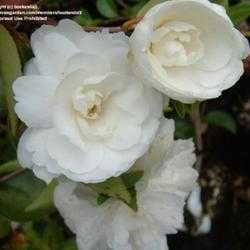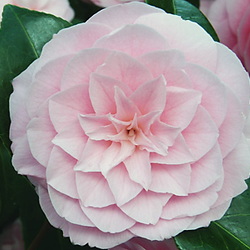(Editor's Note: This article was originally published on December 2, 2009. Your comments are welcome, but please be aware that authors of previously published articles may not be able to respond to your questions.)
The genus is named after a Czech priest and botanist Georg Josef Kamel who travelled in Asia. The most commonly grown plants are varieties of Camellia japonica, as well as the williamsonii varieties which tend to shed their spent blooms and therefore don't require dead-heading. The plants have shiny, dark green leathery leaves and the flowers are fairly large and appear in late winter and early spring. Sasanqua varieties will grow in more sheltered areas or under glass and have scented flowers. The camellia has been cultivated for centuries, and the stunning Higo types were only allowed to be grown by Samurai and other higher classes in Japan.

The first thing to do when deciding where to plant your camellia is to ask yourself if you can provide suitable growing conditions for the plant. They need acid soil (that is one with a PH of 6.0 - 6.5), similar to the requirements of rhododrendrons and azaleas. The cannot tolerate lime in the soil. They also require a bit of shelter and like a semi shaded spot away from hot sun. Another consideration is that the morning sun shining on a plant in a frost pocket can damage or destroy the flowerbuds. Mulching the plants with compost in spring can also help to prevent dryness around the roots in summer which can also be a cause of bud drop. Camellias are hardy in US zones 6-9 and are most widely grown in the south of the USA.
widely grown in the south of the USA.
Avoid planting your shrub near old walls as these can leach lime from the mortar into the surrounding soil. If you cannot provide acid soil conditions then you could consider growing a camellia in a large container as they will do well in this situation as long as they are watered well (use rainwater if possible) and fed in spring using an appropriate plant food for ericaceous plants. They are fairly slow growing plants so they can be grown in containers for a considerable time. Little pruning is required. Using the plants this way means you can move them to a prominent position near the house when they are flowering and then move them again to make way for showier plants in summer. 
You can have camellia flowers in your garden from late autumn until late spring if you choose your varieties carefully. There are over 3000 varieties of C japonica so you have plenty to choose from! Most garden centres stock the plants and you should be able to pick up a 3 litre plant for a reasonable cost. There are specialist online stockists too if you're looking for a particular variety.
Camellia flowers are classified much like roses, in terms of the structure and appearance of the blossoms. There are singles, doubles, semi-doubles, anemones, peony forms (aka informal double), rose form doubles, formal doubles and Higo forms, the latter being single with many flared stamens showing. Colours tend to be in the red, white and pink range, with some flowers exhibiting two colours or splashes of colour.

The shrubs lend themselves superbly to a partially shaded woodland aspect, and in this situation can reach huge proportions which are a magnificent sight in late winter and early spring when they are covered with blooms. Some of the photos in this article were taken by my sister at Howick Hall in Northumberland which is renowned for its 'Silverwood' woodland garden which was started in the 1930s.
Camellias were my mother's favourite plants, and my sister Ann (Galanthophile) now has several of Mam's plants in her own garden which are a fitting memorial to her.
Many thanks to Galanthophile and Growin for the use of their photographs in this article. All other photos are my own.

















